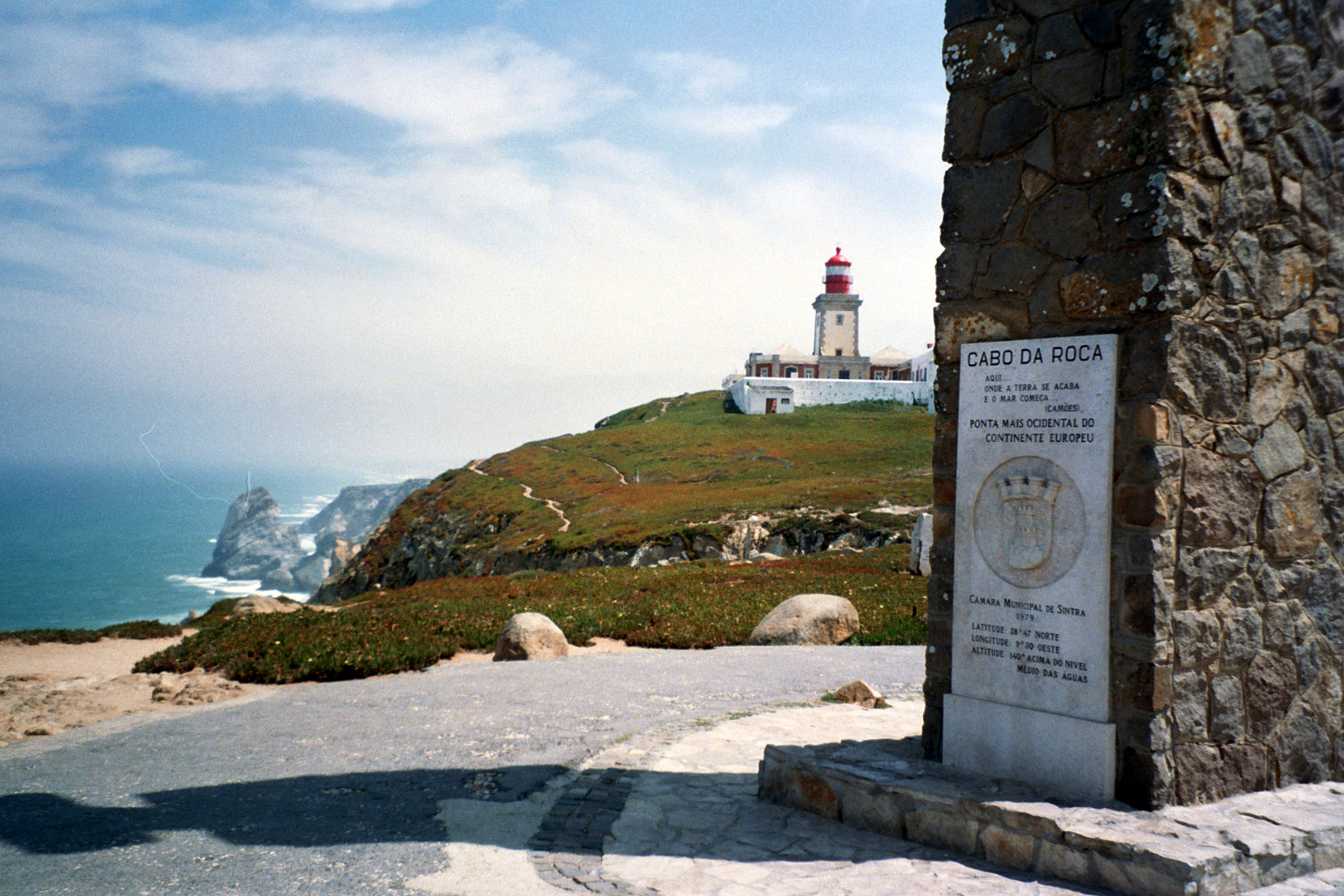Cabo Da Roca (8) - Mar 2010 on:
[Wikipedia]
[Google]
[Amazon]
Cabo da Roca () or Cape Roca is a cape which forms the westernmost point of the Sintra Mountain Range, of mainland Portugal, of continental Europe, and of the Eurasian landmass. It is situated in the municipality of Sintra, near Azóia, in the southwest of the district of



 The cape is within the Sintra-Cascais Natural Park, 42 kilometres west of the city of
The cape is within the Sintra-Cascais Natural Park, 42 kilometres west of the city of
Panoramic view of Cabo da Roca
Lisbon
Lisbon (; pt, Lisboa ) is the capital and largest city of Portugal, with an estimated population of 544,851 within its administrative limits in an area of 100.05 km2. Grande Lisboa, Lisbon's urban area extends beyond the city's administr ...
. Notably the point includes a lighthouse that started operation in 1772.
History
Cabo da Roca was known to the Romans as ''Promontorium Magnum'' and during theAge of Sail
The Age of Sail is a period that lasted at the latest from the mid-16th (or mid- 15th) to the mid- 19th centuries, in which the dominance of sailing ships in global trade and warfare culminated, particularly marked by the introduction of naval ...
as the Rock of Lisbon.
Lighthouse
Geography


 The cape is within the Sintra-Cascais Natural Park, 42 kilometres west of the city of
The cape is within the Sintra-Cascais Natural Park, 42 kilometres west of the city of Lisbon
Lisbon (; pt, Lisboa ) is the capital and largest city of Portugal, with an estimated population of 544,851 within its administrative limits in an area of 100.05 km2. Grande Lisboa, Lisbon's urban area extends beyond the city's administr ...
and in the southwest of Sintra. A location () is inscribed on a stone plaque, located on a monument at the site.
The western coast is a mixture of sandy beaches and rocky cliff promontories: around Cabo da Roca, cliffs are more than 100 metres in height, and cut into crystalline rocks, composed of strongly folded and faulted sedimentary units. These forms are disturbed by dikes and small beaches. This promontory of "high" beaches is the extreme western immersion of the ancient eruptive Sintra massif, as evident from the rose-coloured granite in the north and syenite
Syenite is a coarse-grained intrusive igneous rock with a general composition similar to that of granite, but deficient in quartz, which, if present at all, occurs in relatively small concentrations (< 5%). Some syenites contain larger proport ...
of the Ribeira do Louriçal in the south. In the vicinity of the Cape, there are geomorphological examples of gabbro- diorite, volcanic breccia, and granite.
Part of the granite formations show evidence of strong coastal erosion, while in other areas there are limestone deposits embedded in the granite.
Much of the vegetation on this cape is low-lying and adapted to saltwater and windy conditions. Once home to a variety of plant life, Cabo da Roca has been overrun with the invasive plant species '' Carpobrotus edulis''. This creeping, mat-forming plant, a member of the Aizoaceae succulent
In botany, succulent plants, also known as succulents, are plants with parts that are thickened, fleshy, and engorged, usually to retain water in arid climates or soil conditions. The word ''succulent'' comes from the Latin word ''sucus'', meani ...
family, was introduced as ground cover by local residents several decades ago, but now covers much of the arable land on Cabo da Roca.
Many migratory and marine birds roost temporarily along the cliffs and protected coves of the coastal area.
Climate
The climate present at Cape Roca is extremely moderated by the ocean. Due to seasonal upwelling, the area comprising the cape has cool, stable summers with little to no rainfall but very common occurrences offog
Fog is a visible aerosol consisting of tiny water droplets or ice crystals suspended in the air at or near the Earth's surface. Reprint from Fog can be considered a type of low-lying cloud usually resembling stratus, and is heavily influ ...
which boosts the humidity and decreases insolation
Solar irradiance is the power per unit area (surface power density) received from the Sun in the form of electromagnetic radiation in the wavelength range of the measuring instrument.
Solar irradiance is measured in watts per square metre (W/m ...
. Summer is also the windiest season of the year with July and August averaging around . On the other hand, winters are rainy and have mild temperatures especially during the night, though the amount of precipitation received in this season is unparalleled with other places nearby such as the Sintra Mountains which can receive triple that precipitation. Due to the seasonal lag, September is the warmest month.
See also
* Extreme points of Europe *Cape Finisterre
Cape Finisterre (, also ; gl, Cabo Fisterra, italic=no ; es, Cabo Finisterre, italic=no ) is a rock-bound peninsula on the west coast of Galicia, Spain.
In Roman times it was believed to be an end of the known world. The name Finisterre, like ...
* Pointe de Corsen
* Cape Nordkinn
Cape Nordkinn ( no, Kinnarodden or ) at is the northernmost point on the Nordkinn Peninsula in county, Norway. It is notable for being the northernmost point of mainland Norway, and by extension the northernmost point of mainland Europe. The c ...
* Land's End
External links
Panoramic view of Cabo da Roca
References
Notes
Sources
* * {{DEFAULTSORT:Cabo Da Roca Roca Extreme points of Earth Extreme points of Portugal Geography of Lisbon District Roca Sintra